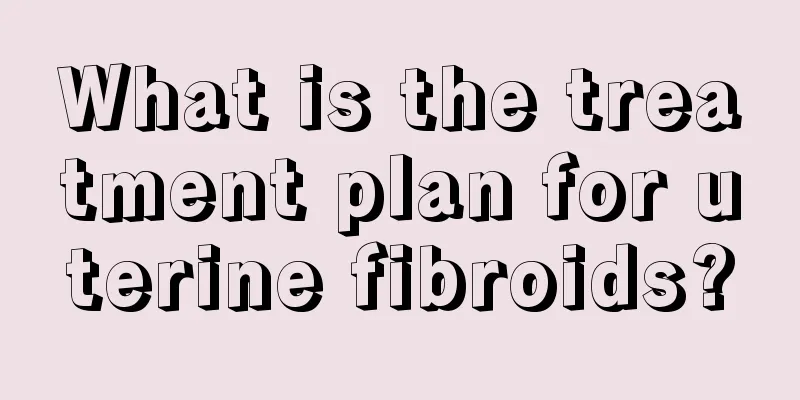What is the treatment plan for uterine fibroids?

|
Gynecological diseases are very harmful to women's bodies. The uterus is particularly prone to certain diseases. Uterine fibroids is a disease with a very high incidence in life, but many women are always particularly afraid of it. Because many women with uterine fibroids have to have their uterus removed, which is very harmful to women's physical and mental health. However, after all, everyone's physical condition is different, and there will be different treatment plans during the treatment process. Let's take a look at the treatment plan for uterine fibroids. What is the treatment plan for uterine fibroids? 1. Follow-up observation If the patient has no obvious symptoms and no signs of malignancy, regular follow-up observation can be performed. 2. Medication (1) Gonadotropin-releasing hormone agonists (GnRH-a) Currently, the commonly used GnRH-a in clinical practice include leuprorelin (Enanton), goserelin (Zoloft), triptorelin (Dapiga), etc. GnRH-a should not be used continuously for a long time. It is only used for pretreatment before surgery, generally for 3 to 6 months, to avoid causing severe menopausal symptoms caused by low estrogen. A small dose of estrogen can also be supplemented at the same time to counteract this side effect. (2) Mifepristone is a progesterone antagonist that has been clinically tried in recent years to treat uterine fibroids. It can reduce the size of fibroids, but the fibroids often grow again after discontinuation of the drug. (3) Danazol is used for preoperative medication or treatment of uterine fibroids that are not suitable for surgery. Uterine fibroids may grow larger after medication is stopped. Danazol can cause liver damage and androgenic side effects (weight gain, acne, dull voice, etc.). (4) Tamoxifen can inhibit the growth of fibroids. However, long-term use may cause enlargement of uterine fibroids in some patients, and may even induce endometriosis and endometrial cancer, so this should be paid attention to. (5) Commonly used androgen drugs include methyltestosterone (methyltestosterone) and testosterone propionate (testosterone propionate), which can inhibit the growth of fibroids. The dosage should be used carefully to avoid virilization. During the bleeding period of patients with uterine fibroids, if the amount of bleeding is heavy, uterine contractants (such as oxytocin, ergot) and hemostatic drugs (such as hemostatic acid, aminobenzoic acid (hemostatic aromatic acid), lizhihemostasis, Panax notoginseng tablets, etc.) can also be used, which can play a certain degree of auxiliary hemostatic effect. 3. Surgery Surgical treatment of uterine fibroids includes myomectomy and hysterectomy, which can be performed abdominally or vaginally, or endoscopically (hysteroscopy or laparoscopy). The choice of surgical procedure and approach depends on factors such as the patient's age, whether or not they have fertility requirements, the size and location of the fibroids, and medical technology conditions. (1) Myomectomy is a surgery to remove uterine fibroids while preserving the uterus. It is mainly used for young women under 40 years old who wish to retain their fertility. It is suitable for patients with larger fibroids, heavy menstruation, compression symptoms, infertility due to fibroids, submucosal fibroids, and fast-growing fibroids without malignant transformation. (2) Hysterectomy is recommended for patients with obvious symptoms, those with malignant fibroids, and those who have no fertility requirements. Hysterectomy can be performed with total hysterectomy or subtotal hysterectomy. For older women, total hysterectomy is more appropriate. The possibility of cervical malignancy must be excluded before surgery. (3) Uterine artery embolization uses radiological intervention to directly insert an arterial catheter into the uterine artery and inject permanent embolic particles to block the blood supply to the uterine fibroids, thereby causing the fibroids to shrink or even disappear. UAE is currently mainly suitable for uterine fibroids with symptoms such as abnormal uterine bleeding leading to anemia. Caution should be exercised when choosing interventional treatment for uterine fibroids, especially for those with uncontrolled pelvic inflammation, those who wish to retain their fertility, those with arteriosclerosis, and those who have contraindications to angiography, which should be listed as contraindications to this treatment. 5% of patients may experience premature ovarian failure after surgery, and there are also rare reports of pelvic infections. 4. Focused Ultrasound Therapy By focusing ultrasound waves and raising the temperature locally inside the tumor to over 65°C, the tumor undergoes coagulative necrosis, which in turn has a therapeutic effect. The treatment can cause the fibroids to shrink and relieve symptoms. Indicated for symptomatic uterine fibroids. The advantages are that there are no surgical scars after treatment and recovery is fast. Adverse reactions have been reported including skin burns, adjacent intestinal damage, and hematuria. The above is an introduction to the treatment plan for uterine fibroids. After understanding it, we know that not all patients need surgical treatment for uterine fibroids. Generally, doctors will give appropriate treatment plans based on the physical condition and the actual situation of the patient. Therefore, female friends should go to the hospital for examination in time when they experience abdominal discomfort, irregular menstruation, abnormal leucorrhea, etc. Generally, the disease is very easy to cure in the early stages of the disease. |
<<: What to do when you are upset during pregnancy
>>: What should I pay attention to when my uterus recovers after a normal birth?
Recommend
I just found out I'm pregnant and I have some brown blood
A little brown blood when pregnancy is detected i...
How long after sex can I use a test strip to detect pregnancy
For women who are eager to have a baby, they all ...
Why do I have leg cramps a week after abortion?
The harm caused to the body by medical abortion i...
There are fleshy bumps next to the nipples
Many people find that there are many small bumps ...
Can you eat vinegar during confinement? Expert advice
Many people know that there are many dietary matt...
Why is baby cabbage called baby cabbage? What are the nutritional values of baby cabbage?
Baby cabbage, also known as miniature Chinese cab...
What causes blood clots during menstruation?
Many women of childbearing age ask whether it is ...
Can Chinese medicine cure gynecological diseases?
Gynecological diseases occur very frequently amon...
Is it painful for women to have their first time?
We all know that when a man and a woman have sex ...
Is it normal to bleed after taking birth control pills?
When taking birth control pills, women must read ...
Wear gloves, wash your hands less often, apply hand cream, use the right medicine, and restore your beautiful "housewife hands"!
Autumn is a season of frequent climate change and...
What is the cause of right ovary enlargement?
Nowadays, many women suffer from gynecological di...
The War on Infectious Diseases - Spring: Chickenpox
This is the 2977th article of Da Yi Xiao Hu Curio...
Why do we spread wood ash when planting? How to apply wood ash when planting ginger?
Wood ash is the ash left after burning firewood. ...
The best time for moxibustion during caesarean section
Moxibustion can not only be used as an auxiliary ...









